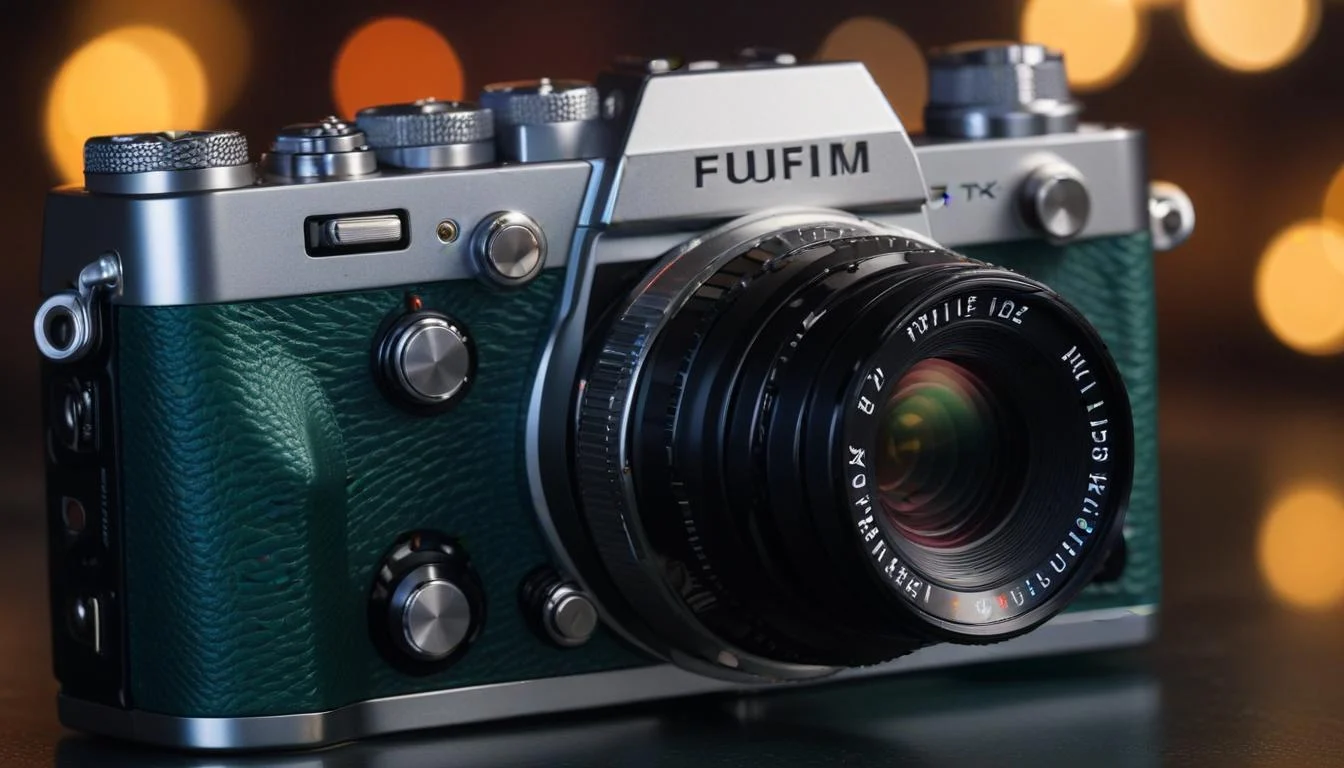 🔔 Affiliate Disclosure
This content may contain affiliate links. If you click on a link and make a purchase, we may receive a small commission — at no extra cost to you. Thank you for supporting BeatInsights! 💛
🔔 Affiliate Disclosure
This content may contain affiliate links. If you click on a link and make a purchase, we may receive a small commission — at no extra cost to you. Thank you for supporting BeatInsights! 💛
The Resurgence of Film & Fujifilm’s Role
The allure of film photography persists in our digital age. Many photographers appreciate the unique aesthetic and tactile experience it offers. Fujifilm’s success stems from its ability to blend this retro appeal with cutting-edge technology. This article explores the resurgence of Fujifilm Camera Retro, focusing on their iconic camera models, innovative film simulations, and overall image quality. We’ll cover everything from the best Fujifilm camera for beginners to a Fujifilm X100V vs X-T5 comparison and delve into a Fujifilm film simulations guide. Furthermore, we’ll even offer a retro camera guide for landscape photography. This guide aims to provide a comprehensive understanding of why Fujifilm has become a dominant force in the modern film photography revival. This comprehensive look at Fujifilm’s offerings should help you determine which camera best suits your needs.
Iconic Fujifilm Retro Camera Models
Fujifilm’s range of cameras caters to various photographic styles and skill levels. Their X-Series is particularly noteworthy for its retro design and sophisticated features. For example, the X100 series (X100, X100F, X100V) is renowned for its fixed lens and exceptional image quality, making it a favorite among street photographers. The X-Pro series (X-Pro1, X-Pro2, X-Pro3) offers a hybrid viewfinder system combining optical and electronic views, appealing to those who value both traditional and modern approaches. Meanwhile, the highly versatile X-T series (X-T10, X-T20, X-T30, X-T4, X-T5), a strong contender for best Fujifilm camera for beginners due to its user-friendliness, provides interchangeable lenses and a wide range of shooting options. Choosing between an X100V and an X-T5 really depends on your individual needs. A Fujifilm X100V vs X-T5 comparison would highlight the compact fixed lens of the X100V versus the more versatile lens options and higher resolution of the X-T5.
Additionally, Fujifilm’s Instax series offers an instant gratification experience. The cameras are compact and user-friendly, creating a tangible link to the nostalgic appeal of instant photography. This complements their broader retro aesthetic perfectly. Beyond these iconic lines, Fujifilm also produces other models incorporating retro design elements, further solidifying their commitment to this aesthetic. However, the X and Instax series remain their flagship offerings in this segment of the market. Consequently, understanding their features is key to making an informed purchase decision.

Fujifilm’s Film Simulations & Image Quality
Fujifilm’s cameras are celebrated for their exceptional film simulations. These are digital emulations of classic film stocks, meticulously crafted to replicate their unique color profiles and grain structures. This is a key differentiator for the Fujifilm Camera Retro brand, allowing users to achieve distinct aesthetic results without the need for extensive post-processing. Popular film simulations include Classic Chrome, known for its muted tones and subtle color shifts, Acros, characterized by its smooth gradation and low-contrast look, and Velvia, famous for its vibrant and saturated colors. Each simulation suits specific shooting scenarios; for instance, Velvia excels in landscape photography. A Fujifilm film simulations guide is available on their official site https://www.fujifilm.com/. The choice ultimately depends on your desired artistic expression. This sets them apart from most competitors.
Furthermore, Fujifilm’s image quality is consistently high. Their sensors offer a wide dynamic range capable of capturing detail in both highlights and shadows. They are often compared favorably to other cameras in the same price range and even to some higher-priced digital models. Ultimately, Fujifilm offers a blend of advanced sensor technology and artistic control, making their cameras an excellent choice for both beginners and experienced photographers. Indeed, the impact of these film simulations is evident in the richness and depth of their images.
Why Choose a Fujifilm Retro Camera?
Choosing a Fujifilm Camera Retro offers many advantages. First and foremost, these cameras combine classic design with modern technology. The retro aesthetic is pleasing to the eye and nostalgic for many. However, these cameras also feature advanced features such as high-resolution sensors, versatile autofocus systems and a wide range of film simulations. A Fujifilm X100V vs X-T5 comparison highlights that versatility but shows that choosing the right camera depends on priorities. A Fujifilm film simulations guide helps tailor your image according to your preference. This makes them suitable for both casual photographers and serious enthusiasts.
Moreover, Fujifilm’s commitment to image quality ensures that your photographs capture impressive detail and dynamic range. The ease of use—particularly beneficial for those seeking a best Fujifilm camera for beginners—further enhances their appeal. The combination of retro design aesthetics and advanced technology makes them a great all-around option. Finally, the availability of a comprehensive ecosystem of lenses and accessories provides even more possibilities for creative expression and flexibility. Therefore, Fujifilm cameras represent a unique combination of form and function. In addition, the brand’s dedication to the unique experience of film photography remains a major draw. Consequently, the popularity of these retro cameras continues to grow. Ultimately, a Fujifilm Camera Retro offers a compelling proposition in today’s market.
Ergonomics and Handling: A Tactile Experience
Choosing your first Fujifilm Camera Retro can be exciting. This guide covers everything from choosing the best Fujifilm camera for beginners to advanced comparisons like the Fujifilm X100V vs X-T5 comparison. We’ll also explore the Fujifilm film simulations guide and a retro camera guide for landscape photography. Fujifilm cameras are renowned for their exceptional build quality. Many models boast a robust magnesium alloy chassis offering durability and a premium feel. The dials and buttons are typically well-placed and tactile providing satisfying feedback with each adjustment. Furthermore, the size and weight often strike a balance between portability and substantial handling. The user experience is inherently intuitive even for beginners thanks to Fujifilm’s clear menu system and logical layout. However, the retro aesthetic might feel different for users accustomed to touchscreen-heavy interfaces. The experience is rewarding though fostering a more deliberate and mindful approach to photography. This tactile interaction is part of the charm.
Consequently, the overall design emphasizes ease of use without sacrificing control. Models like the X100 series are renowned for their compact form factor and superior image quality. Conversely the X-T series offers a more professional DSLR-style body with extensive customization options. This caters to experienced photographers. Therefore the choice depends heavily on your individual preferences and shooting style. Consider the size weight and layout before purchasing. A hands-on experience at a camera store is invaluable if possible.

Community and Culture: A Shared Passion
Beyond the excellent hardware Fujifilm’s success is also due to its thriving online community. This passionate group of photographers shares images tips and technical advice. This online forum is a testament to the brand’s appeal and its connection with photographers. This strong community actively engages in discussions concerning the best Fujifilm camera for beginners and advanced features. You will find detailed comparisons like the Fujifilm X100V vs X-T5 comparison. Moreover this community frequently explores the Fujifilm film simulations guide. The shared passion for Fujifilm’s film simulations and retro aesthetics creates a unique sense of nostalgia and belonging. Many users praise the accurate emulation of classic film stocks. It’s not just about capturing photos but about experiencing a specific artistic feeling.
In addition to online forums websites such as Fuji X Forum offer a wealth of information. You’ll find reviews tutorials and discussions on everything Fujifilm. The nostalgic aspect further enriches the experience. The company’s embrace of retro design and film simulations appeals to photographers who value classic aesthetics and the unique character of film photography. This contributes to the strong sense of community.
Price and Value: Finding Your Perfect Fit
Fujifilm offers a range of cameras to suit various budgets. Entry-level models like the X-A7 offer a fantastic introduction to the system at a relatively affordable price. However for more advanced features and better image quality higher-end models such as the X-T5 and X100V are available. These models command a higher price reflecting their improved specifications and capabilities. Therefore the Fujifilm X100V vs X-T5 comparison often arises. It’s crucial to weigh the price against your needs and budget. A crucial point in the Fujifilm X100V vs X-T5 comparison is considering the respective features. This guides the choice for your specific photography needs. Ultimately the value proposition depends on the individual photographer. It’s also crucial to consider your budget.
The price difference between models often reflects differences in features image stabilization sensor size and lens options. The X-T series generally offers a more professional feature set whereas the X100 series prioritizes a compact design and fixed lens. Additionally consider the cost of lenses which can significantly add to the overall investment. Ultimately choosing the right Fujifilm camera comes down to balancing your needs and budget. Remember that the Fujifilm film simulations guide can enhance your photos.
Choosing the Right Fujifilm Retro Camera for You
Selecting the perfect Fujifilm Camera Retro involves careful consideration of your budget shooting style and key features. Budget-conscious photographers might opt for the X-A series. Alternatively the X-T series offers a wider range of features and higher image quality for more professional use. However for a truly compact and stylish option the X100 series is hard to beat.
Your shooting style also plays a crucial role. Landscape photographers might appreciate the versatility of a camera with interchangeable lenses such as the X-T5 or X-H2. Portrait photographers might prefer the compact and unobtrusive design of the X100V. Street photographers will find the X100V’s fixed lens and discreet form factor ideal. Finally consider essential features like image stabilization weather sealing and video capabilities. These factors influence price and overall functionality. A Fujifilm film simulations guide can help you explore the creative options further. The best Fujifilm camera for beginners often depends on personal preferences.
Conclusion: Embracing the Analog Soul in a Digital World
Fujifilm retro cameras offer a unique blend of modern technology and classic aesthetics. They provide excellent image quality and a wide range of film simulations that capture the character of classic films. This makes them ideal for photographers seeking a distinctive look. The strong community aspect and ease of use further add to their appeal. However, the higher price points of some models must be considered. The retro design and feel of these cameras appeal to those who appreciate the tactile experience of photography. This makes choosing a Fujifilm Camera Retro a rewarding experience.
Resources & Further Reading
- Fujifilm Official Website
- Fuji X Forum
- DPReview Fujifilm Camera Reviews
- Cambridge in Colour: Fujifilm Film Simulations Guide




